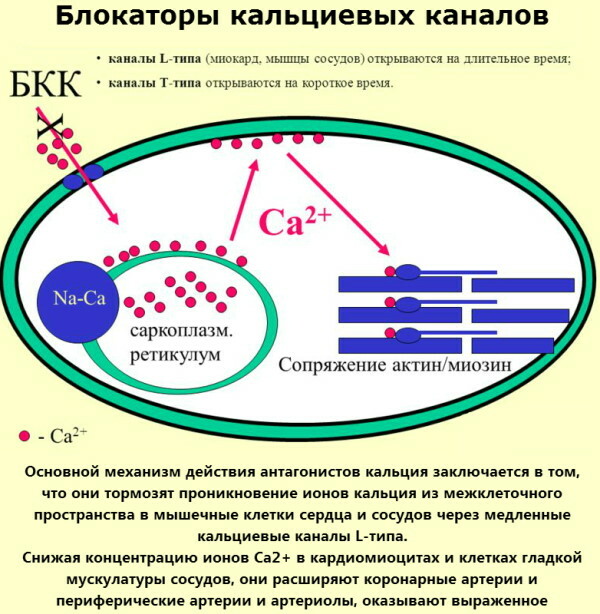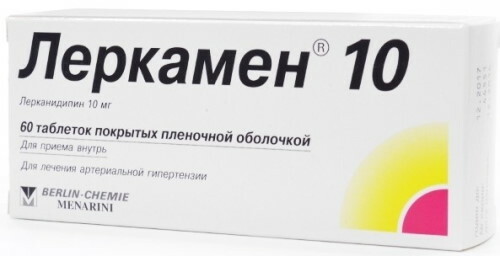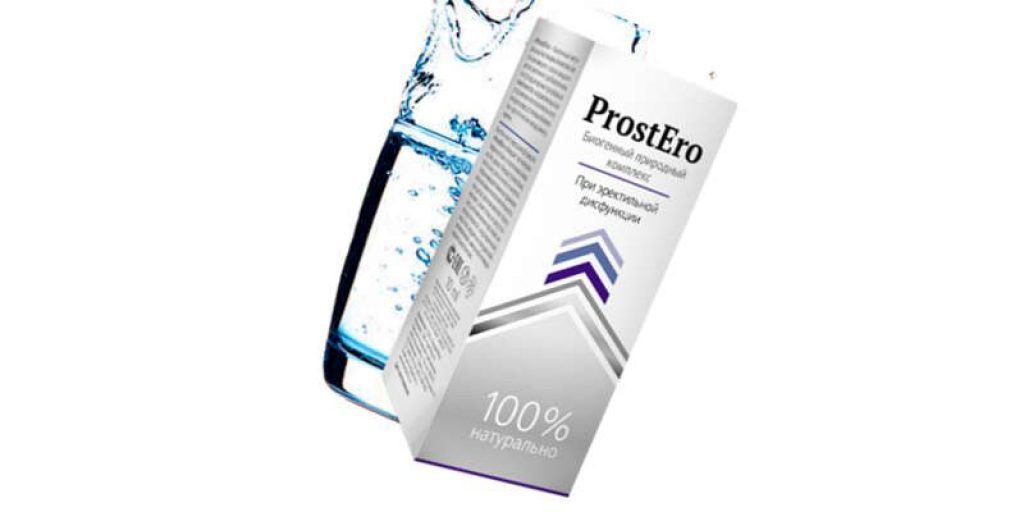Content
- Composition and form of release
- Terms of sale, prices
- Pharmacological properties
- Pharmacodynamics and pharmacokinetics
- Indications for use
- Method of administration and dosage
- Elderly patients
- Children
- Liver and kidney dysfunction
- Side effects
- Overdose
- special instructions
- Drug interactions
- Analogs
- Storage conditions
- Video about the drug Lercadipine
Under the influence of the main substance Lercanidipine reduced general parasympathetic vascular obstruction and blood pressure. The drug is a typical calcium channel blocker that reduces the active transportation of smooth muscle cells of arteries to cardiomyocytes of calcium ions through semi-permeable membrane.
The drug is available in a dosage of 10 and 20 mg. The effect of taking the medication differs in duration, it lasts a day. The drug has no negative inotropic effect. The price of a medicine may differ depending on the pharmacy chain from which it is purchased.
Composition and form of release
The drug is produced in the form of biconvex, round tablets with a yellow shell, with risks on one side.
Active ingredient in 1 tablet (taking into account the dosage):
- lercanidipine hydrochloride - 10 and 20 mg.

| Auxiliary components in the kernel structure | mg |
| Microcrystalline cellulose | 38,5 |
| Anhydrous lactose | 31,5 |
| Sodium starch glycolate | 3,5 |
| magnesium stearate | 1 |
| Additional components in the shell structure | |
| Selectively hydrolyzed polyvinyl alcohol | 1 |
| Titanium dioxide | 0,67998 |
| Talc | 0,444 |
| Polyethylene glycol | 0,606 |
| Inorganic iron oxide pigment: yellow Red black |
0,06825 0,00096 0,00081 |
Terms of sale, prices
Lercanidipine is sold in pharmacy chains only with a prescription from the treating doctor. Depending on the dosage: 10-20 mg, the price of the drug can vary from 200 to 500 rubles.
Pharmacological properties
Lercanidipine 10 mg (the price depends on the pharmacy chain) is a slow calcium channel blocker. Slows down the passive transport of calcium in the smooth muscles of the arteries and muscle cells of the heart.

The action is provided by a sedative effect on the smooth muscles of the arteries, which provokes a decrease in the systemic vascular resistance. It has a long-lasting effect. Due to the increased level of selectivity, no inotropic negative effect is observed. The duration of the therapeutic effect is a day.
Pharmacodynamics and pharmacokinetics
After oral administration of 10 - 20 mg of Lercanidipine, its complete absorption occurs, and the maximum plasma content is reached after 1.5 - 3 hours.
Both lercanidipine inhibitors show identical plasma saturation profiles. After eating, the bioavailability is approximately 10%, due to the intensive metabolism during the first passage through the liver. After oral administration, no later than 2 hours after eating fatty foods, bioavailability increases by 4 times. In this regard, it is recommended to take the medication before meals.
Distribution from the bloodstream to organs and tissues is carried out evenly. The level of binding of the active ingredient to whey proteins is higher than 98%. The original drug is not detected in urine and feces. In most cases, it is transformed into passive metabolites, and about half of the dose taken is excreted in urine. Removal is usually carried out by biological transformation.
The half-life is on average from 8 to 10 hours, and the effect is observed throughout the day, which is associated with a high level of binding of the lipid membrane to the drug.
Taking the medication orally provokes plasma concentrations, which do not depend on the dosage. After the application of 10 or 20 mg, accumulations were observed in a ratio of 1: 3, which indicates a gradual saturation of the metabolism during the initial passage. It follows from this that an increase in dosage provokes an increase in bioavailability.
Pharmacokinetic properties of the drug, depending on the diagnosed pathology:
- elderly patients and suffering from disorders of the functioning of the kidneys and liver, proceeding in a mild or medium stage, are identical to the formakokinetics when taken by other users;
- patients suffering from severe renal dysfunction, dialysis-dependent, there was an increased content of the medication.
Systemic bioavailability in patients with a history of liver dysfunction, moderate or severe, increases. This is due to the fact that the metabolism of the drug is carried out in the liver.
Lercanidipine is a calcium antagonist of the dihydropyridine group, which inhibits the transport of calcium to the cells of the heart and smooth muscles. The drug has a long-term antihypertensive effect due to the absence of an inotropic negative exposure and its increased rate of membrane separation, as a result of high vascular selectivity.

Since the increase in the lumen of the blood arteries, provoked by the intake of medication, is carried out gradually, then the occurrence of acute hypotensive with involuntary tachycardia in patients with hypertension occurs very rarely.
Indications for use
Lercanidipine 10 -20 mg (the price depends on the amount of the package volume and the dosage of the active ingredient) is prescribed for the treatment of stage 1-2 hypertension.
Contraindications
Like any other medication, Lercanidipine has a number of contraindications, in the presence of which, it is not prescribed:
- individual intolerance to lercanidipine, as well as any component of the medication;
- unstable angina;
- decompression syndrome of myocardial dysfunction;
- disorders of the left ventricle;
- severe impairment of filtration, excretory and other functions of the kidneys and liver;
- suffered a heart attack: the first month of rehabilitation;
- carrying a baby and breastfeeding;
- conception planning;
- children under the age of majority;
- inability to digest lactose, lack of lactase;
- complex treatment with ketoconazole, ritonavir, troleandomycin, itraconazole, erythromycin, cyclosporine;
- it is contraindicated to combine with the use of grapefruit juice.
Exercise caution when prescribing if the following pathologies are diagnosed:
- syndrome of disorder of the main activity of the liver and kidneys, proceeding in mild and moderate severity;
- disruption of the left ventricle of the heart;
- syndrome provoked by decompression disorder of myocardial function, chronic course;
- sinus node dysfunction syndrome (without an installed pacemaker);
- simultaneous therapy with terfenadine, quinidine, asmethol, amiodarone;
- complex treatment with non-selective adrenergic blockers, rifampicin and medicines for seizures, as well as digoxin.
Method of administration and dosage
The daily dose is 10 mg once. Reception is shown at least 15 minutes in advance. before meals. The dosage according to the indications can be increased to 20 mg, taking into account the individual patient's tolerance. The increase is carried out in stages, since the therapeutic effect from the beginning of taking the medication reaches its maximum only after two weeks.

Increasing the dosage does not affect the effectiveness of therapy, while the risk of developing negative symptoms increases.
Elderly patients
According to pharmacokinetic data and the results of clinical studies, the choice of the daily dose does not need to be adjusted, despite this, it should be prescribed to the elderly with caution.
Children
Since no clinical studies have been conducted on the use of this drug for the treatment of patients under the age of majority, its use in this category is not recommended.
Liver and kidney dysfunction
When treating patients who are diagnosed with these pathologies, it is recommended to prescribe this medication, having carefully studied the possibility of side effects. The drug can be tolerated normally by this group of people, but it is not recommended to increase the dosage per day to 20 mg.
The effect of the medication in patients with liver dysfunction may increase, therefore, dosage adjustment is necessary. The medication is not recommended for the treatment of people suffering from liver and kidney dysfunctions, proceeding in a severe form.
Side effects
Lercanidipine 10 mg (the price may vary, depending on the pharmacy chain in which it is purchased), like any other medication, it can cause side effects.

| Organs and systems of the body | Possible side effects |
| Nervous | Dizziness or migraines may occur, rarely drowsiness. |
| Cardiovascular | Tachycardia is observed. Angina attacks occur much less frequently. Painful sensations in gridine, fainting, a significant decrease in blood pressure, myocardial infarction were extremely rare. In patients with angina pectoris, attacks may occur more often, be more difficult and longer. |
| Digestive | Rarely there are digestive disorders, pain in the abdomen. |
| Skin and epidermis | Occasionally, rashes may occur. |
| Bones, muscles and connective tissue | Cases of myalgia have been recorded. |
| Kidneys and urinary system | Rapid urination is rarely observed. |
| Immune | Isolated cases, there are reactions associated with individual intolerance. |
| General | Peripheral edema is rarely observed, less often - fatigue and chronic fatigue, in exceptional cases - gingival hyperplasia. |
Overdose
Three cases of overdosing have been officially registered:
- A single intake of 150 mg of the drug with ethyl alcohol (volume not established) caused hypersomnia. Therapy: gastric lavage, oral intake of absorbent agents.
- A single use of 280 mg of a drug with moxonidine at a dosage of 5.6 mg provoked the development of the following symptoms: extreme degree of acute heart failure, severe myocardial hypertrophy, syndrome of all kidney dysfunctions mild stages. Therapy: taking glycosides, plasma substitutes, diuretics, catecholamines in high doses.
- Single use of 800 mg of medication. It caused a feeling of nausea and a strong decrease in blood pressure. Therapy: oral intake of absorbents and laxatives, intravenous dopamine administration.
In all three cases, people's lives were saved.
Exceeding the dose is accompanied by the following symptoms: reflex tachycardia with peripheral vasodilation with a strong decrease in blood pressure, a feeling of nausea.
With fainting, a significant decrease in blood pressure, cardiovascular treatment is prescribed. The effectiveness of hemodialysis due to the high level of plasma protein binding has not been confirmed.
special instructions
When treating patients who have been diagnosed with sinus node dysfunction syndrome (in the absence pacemaker), prescribe a medication, only after studying the ratio of benefits and the likely development of side effects.
During the studies in the treatment of patients suffering from disorders of the left ventricular function of the heart, there was no deterioration of the condition was revealed, despite this, the drug is prescribed only after analyzing the benefits and probable harm. It is believed that in patients with ischemia, the medication may increase the likelihood of worsening cardiovascular pathology.
Occasionally, angina attacks, atrial pain, or myocardial infarction may develop. It is categorically not recommended to combine taking medications with the use of alcoholic beverages. Certain anticonvulsants can reduce the plasma content of the active ingredient, thereby reducing the effectiveness of the intake.
The drug contains lactose, therefore, its use is contraindicated in patients suffering from a lack of lactase, a disorder of the absorption of these elements, or galactosemia.
Clinical studies of the use of the drug during the period of gestation and lactation have not been conducted. In this regard, it is not recommended to use it during this period, as well as to women planning to conceive. As a result of the high lipophilicity of the active component, it can be distributed in breast milk, therefore, the medication is not used for treatment during the period of breastfeeding.
Clinical studies of the use of Lercanidipine have shown that it is unlikely. Deterioration of the ability to drive a car or potentially dangerous machinery is unlikely. But, despite this, it is recommended to exercise caution, since the risk of developing the following side effects is high: asthenia, fatigue, dizziness, drowsiness.
Drug interactions
Lercanidipine 10-20 mg (the price may differ depending on the pharmacy chain in which it is purchased) in complex therapy is prescribed taking into account the interaction with certain drugs.
| Medication | Joint reception with lercanidipine |
| Ketonazole, Erythromycin, Itraconazole | Increases the content of the active component in the blood and provokes a decrease in blood pressure. |
| Cyclosporine | The combination is contraindicated, since such a combination provokes an increase in the plasma content of the components of both medicines. |
| Quinidine, astemizole, terfenadine and antiarrhythmic medicines | Carefully. |
| Anticonvulsants, rifampicin | It is able to provoke a reduction in the plasma of the active substance, which will cause a decrease in the effectiveness of lercanidipine. |
| Digoxin | In patients taking this medication on a regular basis, no pharmacokinetic interaction was found in combination therapy with Lercanidipine at a dosage of 20 mg. It is recommended, when taken together, to carefully observe the appearance of symptoms of digoxin intoxication. |
| Midazolam | Joint reception by elderly patients of medazolam with lercanidipine at a dose of 20 mg, the bioavailability of the latter increases by approximately 40%. In this case, this parameter of lercanidipine is reduced by half. It can provoke a decrease in blood flow in the liver, due to beta-blockers. |
| Cimetidine | At a dosage of 800 mg per day, there is no significant transformation in the concentration of the active component of lercanidipine in the blood. Despite this, it is prescribed very carefully, since higher doses of cimetidine can increase the bioavailability of lercanidipine. |
| Simvastatin 40 mg | Complex therapy increases the AUC parameter for simvastatin by 56%, and β-hydroxy acids by 28%. Avoiding negative interactions will allow taking one medication in the morning and another in the evening. |
| Fluoxetine | In elderly patients, there was no significant transformation of the pharmacokinetics of lercanidipine. |
| Warfarin | The pharmacokinetics of lercanidipine is not affected. |
| Diuretics, ACE inhibitors, beta-blockers | Allowed to combine. |
| Ethanol | Able to provoke a strong decrease in blood pressure. |
It is forbidden to combine the intake of the medication with grapefruit juice, since such a combination inhibits the metabolism of the active component.
Analogs
The therapeutic effects of Lercanidipine's analogs include:
- Zanidip-Recordati;
- Lernicor;
- Lercanorm;
- Lerkamen 10 and 20 mg;

Lerkamen 10. - Coripren;
- Enal L Combi.
Storage conditions
Store Lercanidipine at a temperature not exceeding 25 C in a place that is not accessible to small children. The shelf life of the drug in a dosage of 10-20 mg is 3 years. An expired drug is strictly forbidden to use. The price can be found on the official websites of the pharmacy chains.
Video about the drug Lercadipine
Lercadipine. Analysis of the drug from pressure:



